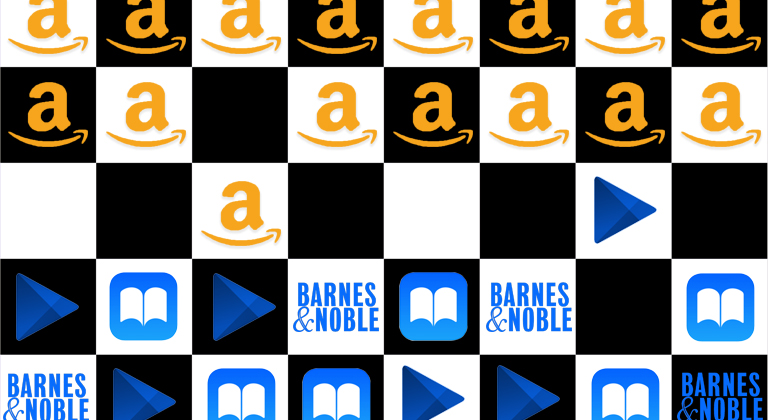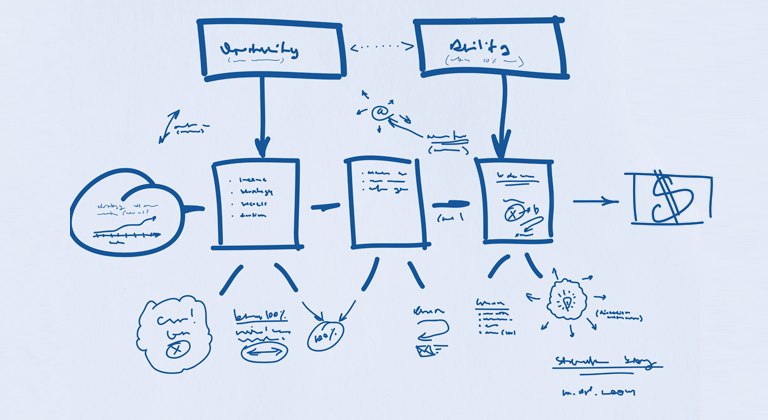Amazon Exclusive vs Wide: A Case Study
The case for going wide or remaining in KDP Select as an Amazon exclusive is fiercely debated, but at the end of the day there is likely no right answer that fits everyone. Like most things, it comes down to experimentation and doing your research. That’s the approach romance author Isabel Jolie took, and luckily for us she was willing to put together this blog breaking down her numbers and what she learned from her experimentation.
To KU or not to KU? It’s a question every author has at least considered and weighed.
“Any romance author should do KU.”
“KU is a no-brainer for a new author.”
These are things I was told – repeatedly. I ultimately chose to go wide, but I did briefly test KU, and the following is what I experienced.
Background
I released my first book in January 2020. In September, I released my fourth book. I’ve seen other authors share sales data and I offered to do so with Hidden Gems because I love the idea of authors helping authors.
I write contemporary standalone steamy romance. Each book leverages a different trope. I mention this to make it clear that in my KU vs wide scenario, it’s not truly apples to apples (but really, in book publishing, nothing REALLY qualifies as apples to apples. There are always variables).
I released my first book via Amazon, BN Press and IngramSpark on January 13 to an abysmal level of sales. Probably no surprise to experienced authors. In January and February combined I sold 249 units and 75% of those sales came from Amazon. I made enormously embarrassing mistakes with keywords and sometime in February I experimented with Amazon and FB ads (horrific results).
In April, I released my second book and did things differently.
- Recognizing that I needed help, I went to Amy Vansant at AuthorsXP. She strongly recommended KU and gave me a list of newsletters to stack and I did so.
- I got a BookBub Featured New Release!
- I got way smarter on category selection (contemporary romance was my only category for my first book – I could write a book on what not to do).
- I also consulted with industry experts such as Craig from Hidden Gems.
The result was that Trust Me earned the best seller tag in several categories. Yay!
Even though I started out dedicated to wide, I ultimately decided that this is my learning year, and heeding advice from the industry experts, decided I needed to test out KU. I also switched ebook distribution from IngramSpark to Draft2Digital. This change is important to note, because with daily reporting available, I could more effectively measure advertising effectiveness.
KU vs Wide Results
For one month – May – I had one book in KU and one book wide. It was a non-release month and for comparative purposes I believe this is important.
Here’s what I found: I made twice as much money on my wide book as I did on my KU book.
Bear in mind, as a new author, I have no following. I especially had no following in May. I didn’t even have a newsletter.
Within Amazon, both titles (the wide and the KU) earned within a dollar of each other in royalties in May. But…my wide title kept on earning outside of Amazon. So, twice the revenue for that title. We aren’t talking big dollars here.
- KU title May earnings: $220 in total. (Sales + 15k page reads)
- Wide title May earnings: $489 in total. ($221 on Amazon, $269 wide)
Now, to be fair, I do suspect that KU magic happens when you have many books in KU and readers can move on to more of your books within KU. As a new author, that’s not a feasible situation. At the time I was enrolled in KU, I had a grand total of two books published.
I moved on, put that KU title back to wide when the three-month exclusivity was up, and have focused wide ever since.
In September I almost achieved the 50/50 milestone – meaning 50% of my income comes from Amazon, and 50% from wide retailers. Even though it was a release month, 54% came from Amazon, 46% wide. Apple, BN Press and Kobo make up the bulk of my wide sales, although I’m also on Google Play and a wide variety of retailers and libraries thanks to Draft2Digital.
For the first nine months total, I’m looking at 62% Amazon revenue and 38% wide. I’m not convinced if I had been 100% Amazon that I would have replaced 38% of my income with KU page reads. Of course, there’s no way to know for certain, unless I discover a time machine and fly back to January 13 and start over (which, hello, 2020…no strong desire to relive this year).
One thing I did notice by accident one day when I was playing around on Publisher Rocket is that while my Amazon sales were pretty much exactly the same, my ranking for the KU title was worlds better than my ranking for the wide title. I don’t pay much attention to rank (bank vs rank any day of the week is my motto) but I can see how someone wanting a bestseller flag might argue KU, or that the mystical Amazon algorithm might kickstart with rank.
All that said, my experience this year has been that Amazon is very much a pay to play environment. If you just put your book in KU, at least as an unknown author, you’re not going to see page reads. You’ve got to advertise. And I’m reading more and more that the only way to really make AMS ads work for you is to bank on income from read-through to other titles.
Which brings me to my next point. I’m better now at AMS ads (thank you Alana and Bonnie at Finding Your Indie). I’m toying with FB ads using Nick Stephenson’s 10K FB strategy. Still figuring FB out. I play around with BookBub ads, too. Always learning.
In my first 9 months, I’ve earned almost $10K in revenue. I have no idea if that’s good or bad. I can say that I’m probably hovering around break-even when calculating editor fees, book cover designs, classes and marketing expenses. And that’s okay with me. This is a new business and most new businesses re-invest every dollar they earn.
What I’ve Learned
These are my key take-aways from the first 9 months:
- KU might work for some, but it didn’t work well for me with only one book enrolled.
- Amazon is pay-to-play. For that matter, all retailers are, but free promotions may be more readily available on other retailers. Theoretically, while still high, competition is less intense for the romance genre on non-Amazon retailers. My highest CPC on BB ads is to target Amazon readers. iBooks/D2D gave me my first free promotion (sneak peek at my release) and I love them for it. Kobo has promotions at very low costs, and BNPress has free ones as well. I haven’t been approved for a Kobo or BNPress promo, but the name of the game is to never give up and keep applying.
- BookBub is king. All hail BookBub.
- Written Word Media properties performed quite well for me, too. If anyone is interested, Wide for the Win, a truly great FB group for wide authors, has a whole list of newsletters that work.
- The 99-cent sale works great for newsletters and for releases when you are starting out. My fourth book released at $2.99. While my unit sales are lower than the prior two releases, my revenue is more than double.
- I’ve had two BookBub Featured Deals. One was for a 99-cent title and one was FREE (my free BookBub ran 7 days before release day of my full price title). Even before my 4th title released, I made more revenue stemming from the FREE BB than the 99-cent BB. This is a little factoid I’m still pondering.
- Some have said that being wide improves your chances of getting a BookBub. I don’t know if this is actually true, but if it is, it’s a huge reason in my mind to be wide.
- My newsletter is important. I started the year with zero subscribers and now have over 2,000. Not a sizeable list by any stretch, but large enough that I saw a sales lift with my most recent new release email, and I definitely saw an impact when I announced a giveaway I was running.
- New authors must be wary when reading other author’s accounts of what works. Marketing strategies differ by genre (i.e. what works for nonfiction may not work for romance). Authors with 20 books in distribution ultimately earn more with a single book sale and have a backlist to leverage. In a nutshell, they have a different game board. It’s always interesting to read what works for other authors, but there are no guarantees their playbook will work for you. The publishing world is evolving, and what worked last year may not work this year (OK – I don’t really know this from my first 9 months, but I have a marketing background and I know this in general). Everything must be tested.
- There is joy in not boarding the Death Star. Root for the little guys, the force is strong.












Thanks for the article and data points.
I did want to point out one fallacy that you started to touch on but missed. That is Amazon Sales Rank. It is very important on Amazon, critically important in my opinion. It is used by the Amazon algorithm in making recommendations to readers, positioning within searches, and almost every other aspect of organic sales.
You said that you would have to make up lost wide sales with page reads and believed you would not. However, in calculating Sales Rank, every KU borrow is considered a sale. Therefore, the additional reads would have driven Sales Rank higher, (lower Number) and made your book(s) more relevant to the algorithm. This would drive even more sales and reads. Therefore, your lost wide revenue would come from additional sales and reads.
I have put some of my books wide from the time of publishing, and still have some of them wide. Their total sales wide do not come anywhere near what I make being Amazon exclusive. But, it was not always that way, having a good back catalog is where it is at.
I released a book a couple of months ago that rocketed into the top 100 for the categories the first day. What followed was two other older books moving back into the category top 100, all driven by a large number of KU reads. KU readers do move into the back catalog if they like your book. They are loyal and voracious readers.
All that said, it is not something that I believe will ever be settled. There are too many variables between individual authors, books, and genres to really sleuth out.
Thanks again for the great article
Isabeeeellllll!!
So good to see you over here. 😀 Great article and thanks for the Wide for the Win shoutout. ❤️ I’ve heard the same thing as you (KU is best for romance; KU is best for new authors) for YEARS, and it simply isn’t true. KU is best for…
Nobody! 😁
Thanks again for a great article.
Hey Izzy,
Going through the same steps as you, writing steamy con roms but with far, far less success. Done the Nick Stephenson’s 10k readers, Publisher Rocket and polishing KU skill with Bryan Cohen. My con rom Karma’s Slow Burn was released in February and it was excruciating. Just released Mr.Go Slow, a pickle ball romance, and going through similar birthing pains. I keep going on and off KDP Select but you’re right, going wide brought in more revenue for me too. What’s keeping me from doing it again? Filling out the forms on D2D and Smashwords.
Best Nalini
Hey Nalini! Keep at it! As for those forms – I schedule it on my calendar and tackle it on the weekends. When I have something to distribute, that is. I find that if I plan to do it and jam through, it’s almost like an assembly line. You get faster as you go. I love D2D!!! Maybe I’ll see you in the 10K FB group…or Wide for the Win!
Great read and that’s an excellent start in the business. Kudos! By the way, it’s “IngramSpark.” 😉